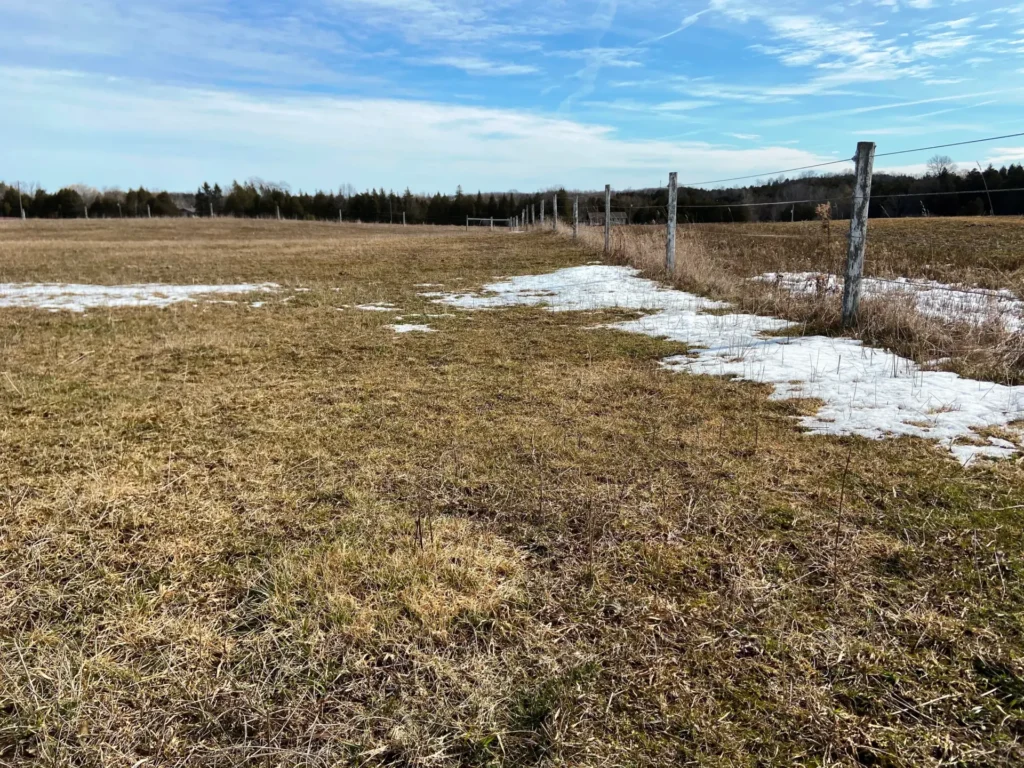Frost Seeding Pastures



Frost seeding by broadcasting forage seed on frozen ground is a simple, low cost method of improving the yield and quality of older, thinning, “run out” pastures. It relies on the freeze-thaw action of the soil in late winter to provide adequate seed-to-soil contact. This window commonly occurs from about mid- to late-March in most of southern Ontario. Moisture from melting snow and spring rains helps early germination and growth. Broadcast seeders are commonly mounted on ATVs or a tractor 3-point hitch.
Legume Species
Experience has shown good success with legumes such as red clover, white clover and birdsfoot trefoil. Legume seed is dense and rounder, which improves seed-to-soil contact. Added legumes will provide nitrogen to the existing grasses to provide additional overall yield.
Red clover is the most common species used in frost seeding. It establishes early, quickly and easily. It is relatively inexpensive but is short-lived, so many farmers frost seed it at 6 – 8 lbs/acre every 2 – 3 years. It is a cost effective way to provide nitrogen to the pasture stand.
White clover is commonly seeded at 1 – 2 lbs/acre. Because it spreads and thickens with stolens over time, it can be more persistent.
Birdsfoot trefoil is slower to establish, but has the ability to reseed itself over the years providing more persistence. It may take a year or two to see much trefoil in the stand. However, trefoil has an important advantage of being non-bloating, so can be included at higher seeding rates than clovers.
Alfalfa is more expensive and less successfully frost seeded, particularly where alfalfa plants already exist and create alfalfa autotoxicity.
Grass Species
Grasses are more challenging to frost seed than legumes because the seed is coarse, less dense, light and fluffy, so proper seed-to-soil contact is more difficult. Higher seeding rates can help compensate for a lower rate of successful germination and establishment.
The best frost seeding success is usually achieved with perennial ryegrass, festulolium and orchardgrass. These species germinate more quickly, with strong seedling vigour and growth. However, ryegrass and festololium are less persistent.
Reed canarygrass, timothy and bromegrass are usually less successful in frost seeding, and more successfully established with a no-till or conventional drill in early spring. Meadow bromegrass is usually preferred over smooth bromegrass in pasture situations.
Tall fescue and meadow fescue are intermediate in successful frost seeding, but very productive once established.
Other Management Tips
- Frost seeding is more successful when there is some bare soil and competition from the existing stand is reduced. This is accomplished by grazing the pasture short in the fall. Thick sods and those with a heavy thatch layer are less successful.
- Frost seeding works best on loam or clay soils but is less successful on sandy soils.
- Seeding on top of a thin layer of snow can help to see the spread pattern, with a more even application. Too much snow can result in runoff of seed.
- When legume and grass species are mixed together and a spinner spreader is used, the grass seed will not “throw” as far as the legume. This can often result in uneven strips of legume and grass. Two passes can be done to prevent this.
- A spring nitrogen application following a frost seeding can stimulate excessive competition by existing grasses to new seedlings, so it should be avoided.
- Allow spring pasture growth to get to 8 – 10 inches to ensure seedling establishment, and then graze to prevent excessive shading of newly established plants. Continuous grazing and overgrazing can significantly damage new seedings, so some rotation is advised.
- In emergency situations, frost seeding is sometimes done to patch damaged hay stands. This is a cheap but higher risk option. Overseeding with a no-till drill is usually a more consistent, preferred option.
